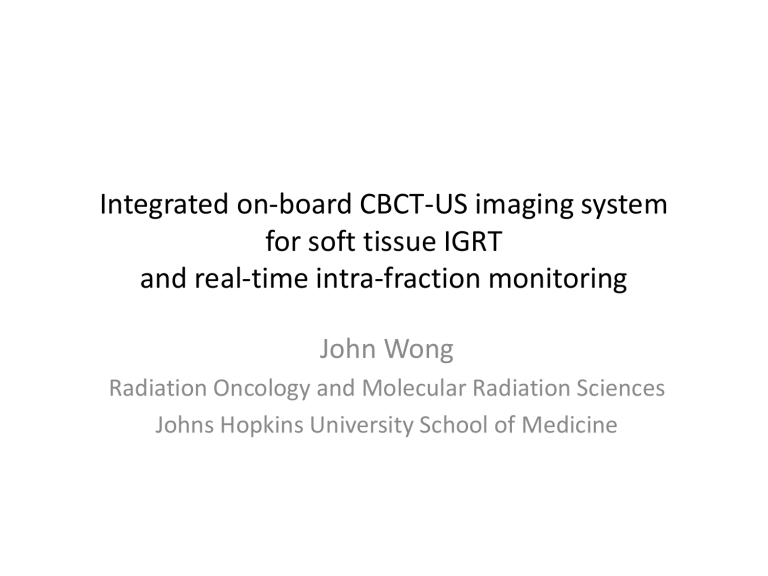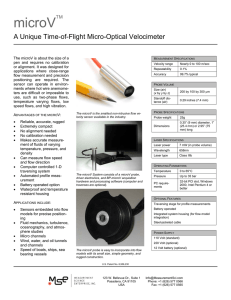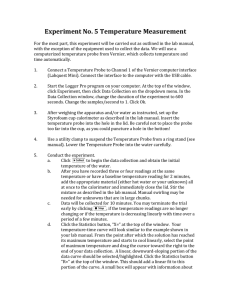Integrated on-board CBCT-US imaging system for soft tissue IGRT

Integrated on-board CBCT-US imaging system for soft tissue IGRT and real-time intra-fraction monitoring
John Wong
Radiation Oncology and Molecular Radiation Sciences
Johns Hopkins University School of Medicine
Acknowledgments
• R Teboh Forbang --- Radiation Oncology
• M A Lediju Bell, H T Sen , P Kazanzides, I Iordachita
– Laboratory for Computational Sensing and Robotics
• U Hamper, R DeJong --- Radiology, Ultrasound Section
• D Ruben --- Comparative Medicine Technology
• P Xia, K Stephans, Y Zhong --- Cleveland Clinic
• M Lachaine --- Elekta, Soft Tissue Imaging
Supported in part by:
NCI R01 CA161613; Academia-Industry Research Partnership
Elekta Sponsored Research Agreement
Challenges of Soft Tissue IGRT
Inter-fraction methods: Cone beam CBCT, MV CT
Volumetric information Snap shot
Adaptive Radiation
Therapy
Ionizing radiation
Image Quality
Inter-fraction methods: Intra-modal ultrasound imaging
Soft tissue information Snap Shot (at present)
Non-ionizing Expertise/operator dependence
Intra-fraction methods: Implanted Mar kers
Real-time monitoring Invasive
Non-ionizing option Ionizing radiation
Soft tissue surrogate (truth?)
• Emergence of MRI-Radiation Machines
Integrated 3D ultrasound/CBCT imaging for soft tissue IGRT
Hypothesis:
• US-CBCT offers an nonionizing, non-invasive inter- and intra-fraction solution for soft tissue targets
• Prostate, liver, pancreas
(a) CT only
(b) CT with ultrasound
Challenges of US imaging
Reproducibility / operator dependence
Solutions
Robotic placement of a 3D probe
Deformation of anatomy
Keep US probe in place during irradiation while avoiding beams
Intra-fraction monitoring
Soft tissue registration
By definition, auto-fusion of
CBCT and real-time US
Require simulation/planning of patient in treatment position with the ultrasound/CBCT system in place
SBRT Liver Planning Studies with Probe on Patient (n=10)
Plan-Clinical Probe-Parallel Probe-Vertical
Liver SBRT Dosimetric
Endpoint Comparing
Plan-Clin US-Para US-Vert
D95 - PTV
(Gy)
38.72
± 0.14
38.63
± 0.14
38.48
± 0.31
P>0.05
V15 - Liver
(cc)
363
± 38
355
± 48
367
± 39
P>0.05
• Except for the superficial lesions of 2patients, the remaining
8 can be treated with probe in place.
• Probe-parallel allows 7 coplanar/1 non-coplanar treatments
• Probe-vertical allows 2 coplanar/6 non-coplanar treatments
CT artifacts from Ultrasound Probe
• Need a model probe to avoid planning CT artifacts for planning and CBCT setup
• Require probe exchange
• Need to demonstrate reproducible placement and deformation
Reproducibility of model probe using CT:
Passive (1D) robotic arm and gel phantom
Vernier scale compressor
Model probe
• Deformable gel phantoms with 12 embedded PMMA beads
(1.2, 2.8, 3.2 mm in diameter)
• Compression Force ~ 5 N (~0.5 kg)
Reproducibility studies with model probe
BB2 BB2
• CT (1 mm) slice scans of repeat cycles of w/wo compression
• Intra-scan: Compare displacement due to compression
• Inter-scan (1 day apart): Compare the difference of two separate measurements after accounting for setup error
• All beads’ positions were reproducible to within 1 mm
Workflow: Robotic Assistance
Treatment Planning Treatment Delivery
Position patient on couch
Place US probe with robot for imaging
Align patient with lasers
Robot records position and force information
Acquire CBCT, compare to simulation & adjust couch based on bony anatomy
Substitute US imaging probe with model probe
Place US probe with robot using recorded position and forces
Acquire CT simulation image with deformed tissue
Treatment planning
Real-time monitoring with US probe
Cooperatively Controlled Robotic Placement force sensor
Measured force
(applied by user)
Desired velocity
(to robot controller)
K
Cooperative Control
(no virtual fixtures)
• Safety concerns regarding autonomous motion
• The need to adjust for setup error, anatomical changes, etc.
– Human operator will be involved
• Implementation of virtual fixtures:
– Enable less-skilled user to reproduce deformation (e.g., similar position/force) during inter-fraction treatment
Cooperative Robotic Arm for Probe Placement
Prototype Cooperative Robot for Probe Placement
3-Active Degree of
Freedom Linear Stage
Passive Arm
2-Active Degree of Freedom
Rotary Stage
Orthogonal
Probe
Positioning
R&D Robot GUI:
Study of positional or force control
Ex-vivo Bovine Liver in gel phantom
• Gel phantom was overly simplistic with uniform deformation
• A more realistic ex-vivo liver phantom was devised
• Comparison of deformation was made between ultrasound and model probe.
Reproducibility of Deformation
Contact forces lower with model probe
The robotic arm needs to be stiffened
• Significant compression force differences between gel and liver phantom
• Suitability of phantom material is of concern
8/5/2013 20
X-ray CT – Ultrasound IGRT :
In vivo feasibility studies
• DO13M143: “Reproducibility of probe placement for combined US-CT imaging”
– Most realistic subject
• Reproducibility of induced deformation
– Between clinical US probe and model probe
– Intra-fraction during a treatment/simulation session
– Inter-modality from simulation to treatment
– Inter-fraction on different days (analysis in progress)
DO13M143
• Laboratory dogs: 4 planned, 1 studied
• Three spherical stainless steel markers (2.38 mm dia) implanted in the prostate, liver, pancreas
– 1-2 organs were studied per week
• Helical CT of displaced marker positions due to robotic placement of imaging and model probe
– no probe, imaging probe, model probe
• Focus of first dog study over 4 weeks:
– Workflow; system configuration; …
– Intra-fraction variation
8/5/2013 23
Prostate (Force = 14 N)
CT with real probe
Prostate Images
Ultrasound
CT with model probe
0
1
Prostate (Force = 14 N; 10 N ~ 1 kg):
Marker Position Reproducibility in Interquartile Range
2
Real Probe: 3D mean error=0.6 mm Model Probe: 3D mean error = 0.7mm
1
0.5
LR
0.6
0.4
0.2
0
AP
0
SI LR
No Probe: 3D mean error = 0.4mm
LR AP SI
AP SI
Prostate:
Probe-Induced Marker Displacement (from no probe)
3D mean error
= 0.2mm
Liver at Breath-hold (Force = 40 N)
Liver CT and Ultrasound Images
Liver (Breath-hold):
Marker Position Reproducibility in Interquartile Range
0.4
Real Probe: 3D mean error=0.3 mm
0.3
0.2
0.1
0
-0.1
Model Probe: 3D mean error=0.6 mm
0.4
0.3
0.2
0.1
0
-0.1
No Probe: 3D mean error = 4.7mm
5
0
Liver (at Breath-hold):
Probe-Induced Marker Displacement
3D mean error
= 4.1 mm
Pancreas (Force = 34.5N)
Pancreas (at Breath-hold):
Probe-Induced Marker Displacement
Real Probe: 3D mean error = 1.6 mm
2.5 2.5
Model Probe: 3D mean error = 1.1 mm
1.5
2.0 2
1.5 1.5
1.0
1.0 1
0.5 0.5
0.5
0
0 0
LR AP SI
No Probe: 3D mean error = 1.3mm
1.5
1.0
0.5
0
Pancreas (at Breath-hold):
Probe-Induced Marker Displacement
3D mean error
= 4mm
Conclusions
• CT of implanted markers provides a direct validation of reproducible deformation due to probe
• Choice of phantom is important to study reproducibility for ultrasound guidance (Force: 1 to 40N)
• Prostate deformation is reproducible to within 1 mm
• Results for liver and pancreas can be improved
– Experience; no visual feedback; un-optimized system
• More in vivo (dog) IGRT studies to:
– refine the system
– Inter-fraction study on a CBCT machine
Robot System Requirements
• Repeatable mounting of US probe and model probe
• Record probe position and contact force (in simulation)
• Enable operator to reproduce position and force when switching between US and model probes
• Hold model probe in place during CT or CBCT acquisition
• Enable less-skilled user to reproduce deformation (e.g., similar position/force) during inter-fraction treatment
• Hold US probe in place during treatment
• Sufficient workspace to scan abdominal organs: prostate, liver, kidney, pancreas (as we discover!!!)
Kidney
Dose Volume Histograms
US Probe in Plans
Clinical Plan
PTV
Health Liver
Dose (cGy)





